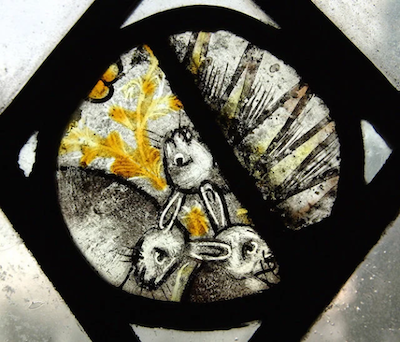

Rabbits are different companions than other animals. They are more independent than dogs or even cats. Through the course of their coexistence with humans, they gradually get close to us, play with us, feel relaxed and trust in our presence. I live with an Orange Rex called Beaufort, known as Beau.
Beau was destined to live in Beaufort Castle, a uniquely designed two-storey hutch with a fox-proof pen in the garden of the Margaret Beaufort Institute of Theology, Cambridge. He ended up with me in a one-bedroom flat without a garden. He has a carpet as his meadow, books instead of twigs to chew on (biblical commentaries are amongst his favourite, despite not being easy to digest) and curtains to practise his tailoring skills.

He seems to be a contented bunny with the same key characteristics that his fellow species display in the wild. He has many qualities. Three of them have a special significance to me: adaptability, alertness and routineness. Beau adapted exceptionally well to his new environment. He recently got promoted to the position of my research assistant, given his interest in books and the laptop. He is a master of alertness. Any change in the flat, a new sound, voice or visitor makes him vigilant and attentive. He seems to flourish thanks to a balanced routine of sleeping, relaxing, eating and playing. I could set my clock according to these activities. Their rhythm is almost identical each day, including his tranquil “participation” in my prayer time.


Beau has been helping me to appreciate the simple rhythm of life. “How we spend our days is how we spend our lives,” says Annie Dillard in her book Writing Life. “What we do with this hour, and that one, is what we are doing.” I want to add: what we are doing this hour is also “doing us.” When I look at Beau, especially when he is resting or cleaning himself (rabbits have the cutest way of cleaning their ears and nose, almost as if in a prayer pose), I see a creature who is totally present to himself while being in the presence of the other. His deep and shiny black eyes and his twitching nose have countless ways of communicating with me and telling me that he simply is.
Thanks to Beau I am rethinking what Real Presence means, sacramentally, emotionally, practically and educationally. Busyness and not having time to be properly present can be a mask. In the era of mask wearing, Beau is helping me to unmask some important issues that carry theological and spiritual significance. Animals are a mystery to us. They are more in tune with us than we would ever be able to understand. It is not surprising that rabbits feature in one of the earliest representations of the Holy Trinity. There are two artworks with rabbits that I like most: an icon of St Melangell, the 6th-century Welsh Saint and the 15th-century Rabbit Roundel in the church of Holy Trinity, Long Melford, Suffolk. These works as well as Beau help me to go beyond myself and touch the sacred.
Dr Anna Abram is Co-Principal of the Margaret Beaufort Institute of Theology, Cambridge, UK. Her academic field is Christian ethics.


The Kirby Laing Centre for Public Theology in Cambridge. Charity registered in England and Wales. Charity Number: 1191741
Kirby Laing Centre, Office 1, Unit 6, The New Mill House, Chesterton Mill, French’s Road, Cambridge, CB4 3NP
© 2025 The Kirby Laing Centre for Public Theology in Cambridge